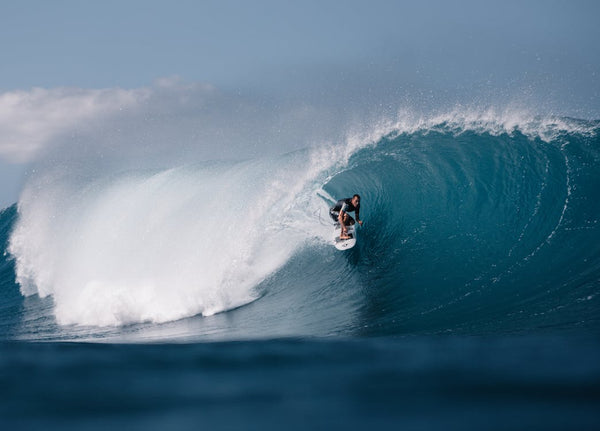Understanding Big Wave Boards (and the Other Gear You Need to Charge!)
Share
Written by Matt Rode
For the majority of us who ride modern performance designs, most of our time is spent on grovelers, standard shortboards, and maybe the occasional step-up. But every now and then, the waves get a bit too big for a 6’2—and that’s when the hellmen and women among us start breaking out the serious foam.

Boards for big waves have a long and storied history—one that was predominantly written right here on Oahu. From the guns of Pat Curren and Dick Brewer to the modern semi-guns of Wade Tokoro, the North Shore has long been the creative hotbed for heavy water designs.
But what exactly constitutes a big wave board? That sort of depends on the person and the size of waves they consider to be “big”—because in an age when world records are quickly approaching 100 feet, size is certainly relative.

At the bottom of the big wave spectrum is the mini-gun/semi-gun. Essentially a stretched out shortboard, miniguns are typically tweaked with a bit of extra rocker in the nose, some vee in the bottom contours, and one of many variations on the rounded pin in the tail. This board is intended to be a compromise between a shortboard and a gun. It has subdued versions of the design elements that give big wave guns their stability and control, and is built to go fast and handle high speeds—but it also preserves some modicum of maneuverability so that it can be positioned in the most critical parts of the wave.

These mini-guns tend to range from 6'4" to 7'6" and are the types of boards you are likely to see out at Pipeline and other big, heavy barreling waves. They are designed to make big drops and ride big barrels—and in the case of the world’s best surfers, still do big turns (see Tom Carrol’s famous “Snap” for an example of how a mini-gun can still be shredded).
The area between approximately 7'6" and 9'0" is sort of a mystical range of board lengths that not many people are able to adequately define. Not quite big wave guns, but definitely larger than your typical minigun, these boards are typically used at spots like Sunset Beach, Second Reef Pipe, and Puerto Escondido, where the waves are commonly between 8 to 12 feet and have that deeper-water big wave feel. They tend to be a bit gunnier than mini-guns—the tails are a bit more drawn in, the outlines are straighter and narrower in relation to the length, and there tends to be a bit of extra volume introduced through thickness (often hidden up near the chest). These boards are built to paddle you into big, fast-moving waves, and then travel at high speeds through big barrels and pocket rides. They aren’t likely to be doing any snaps in the pocket, but they should still be able to carve.

Finally, at the extreme end of the spectrum are true big-wave guns, which have been refined over the years to the point where they are now regularly being paddled into waves between 40 to 60 feet on the face. These boards tend to be 9'0" to 10'6" in length (although some outliers ride guns as short as 8'6" and as long as 11'0"), 20 to 22 inches wide, and 3 to 4 inches thick, with drawn-in pintails, relatively straight outlines, lots of vee in the bottom, and hard rails pretty far up from the fins.

Like most shortboards and mini-guns, big-wave guns tend to come with five fin boxes, in order to give riders the option to use either a quad or thruster setup. Quads are faster and help big wave surfers make it around large sections on big waves, while thrusters handle chop and bump better and are ideal for windier days. Some traditionalists still enjoy riding single-fin guns, although these are typically only used at shorter, traditional big wave spots, where down-the-line speed isn’t as essential, such as Waimea Bay.
In addition to the right board for the conditions, it is also important to have the right surf accessories. For the waves that are ridden on a mini-gun, you will typically want a 7-foot leash with decent strength (no comp leashes!), whereas big-wave leashes for waves from 12 feet and up tend to be very thick and between 10-12 feet long. Fins for bigger waves also tend to be a bit bigger, heavier, and stiffer, often made of fiberglass rather than composites. Finally, when venturing into XL surf (or even large surf that is heavy and hollow), it is a good idea to use floatation.
While you will likely never need it, an impact suit can help bring you to the surface in the rare instance that there’s an accident where you lose consciousness, so that your fellow surfers can rescue you. And once the waves get past a certain size, it is a good idea to wear an inflatable vest (also known as a PSI vest).
Now that you are adequately geared up for big waves, it’s time to think about training and preparation—which is what we will talk about in our next blog.


